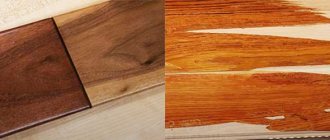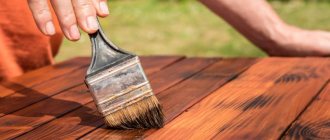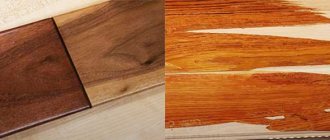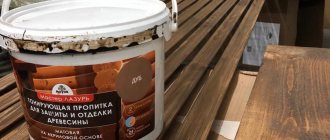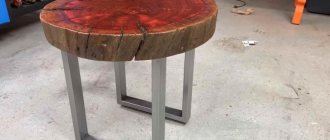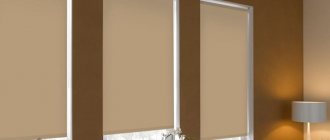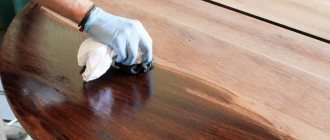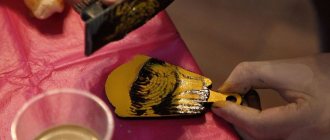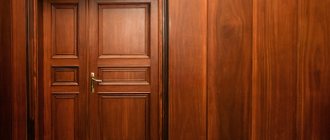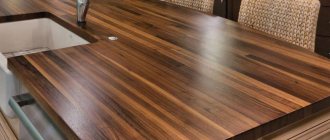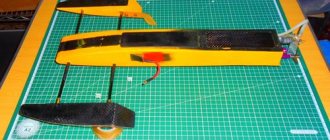To finish wooden products, in addition to paint, varnish or drying oil, a special substance can be used - stain (stain). It has a number of technical features. In our article we will learn about the best stain for wood - what it is, what technical features it has, and which liquid to give preference to when choosing.
Wood stain
Stain - what is it
Stain (stain) is a coloring composition for wood that enhances the natural color of wood and preserves its texture. Stain is usually used to paint furniture, small decorative items, doors or windows. It tolerates ultraviolet radiation well, so it can be used to cover surfaces both at home and outdoors. Beitz emphasizes and enhances the natural beauty of wood, and painted parts look stylish and aristocratic.
Attention! The composition is used only for impregnating wood - it is practically useless for other materials.
Why do you need stain?
In addition to its decorative function, stain also solves a number of other problems:
- Lightening/darkening wood.
- Protection from pests and mechanical deformation.
- Compaction of the material structure.
- Protecting wood from moisture and sunlight.
Difference from drying oil, paint, varnish
In terms of technical properties, drying oil, varnish and paint are similar to wood stain. However, there are a number of important differences between them - they are listed in the table:
| stain | Penetrates deeply into the wood, but does not close its pores, which allows you to preserve the natural pattern. Stain is used for self-finishing, with which you can restore the natural color and texture of wood |
| Drying oil | Penetrates weakly into the wood, but creates a thin, durable film on its surface. Drying oil performs a technical function - it prepares the wooden surface for further painting and varnishing |
| Varnish | It does not penetrate into the wood, but creates a super-strong film on its surface that protects against precipitation, mechanical deformation, and sunlight. The varnish performs primarily a technical function, but can create a pleasant shine on the surface |
| Dye | Does not penetrate into the wood, but creates a thin colored film on the surface. Paint is used for external finishing of surfaces (does not perform a protective function), and with its help you can completely hide the natural texture of wood by painting over it |
Table of differences
PRODUCT DESCRIPTION:
High quality colored primer for wood floors and furniture. Compared to traditional coatings, the product is based on herbal ingredients, which allow you to achieve uniform coloring without gaps or sagging. Color intensity ranges from transparent to rich. Easy to use - no intermediate sanding required. Saves time and money! Finishing with colorless Osmo-oil Hartwachs-OL Original is required.
- Leaves wood pores open.
- Does not crack, does not peel, does not peel off.
- Resistant to stains from water, wine, beer, cola, coffee, tea, juice, milk (EN 12720).
- The dried coating is safe for people, animals and plants.
- Resistant to saliva and sweat (DIN 53160).
- Suitable for children's toys (EN 71.3).
Which stain to choose?
Choosing a stain
When selecting a stain, focus on the following parameters:
- Composition type . If your budget is limited, water stain is suitable for tinting. But it is not recommended to use it in open spaces - use alcohol stain instead. If everything is fine with the budget, then it is recommended to use an oil or acrylic composition.
- Wood color . Typically, people use stain to age wood, making it look more aristocratic. For these purposes you need to buy a dark Benz. If you are working with dark wood, you can use a lightening stain.
- By method of sale . Stain is sold in powder or liquid form. The powder has a longer shelf life, but it must be prepared before use (fill with water or solvent depending on the type of stain). Liquid mixtures are ready for use, but they do not last long.
Wood stain video
Classification of stain
On sale you can find compositions based on water, alcohol, oil, wax, and acrylic.
Water based
The composition is sold in the form of a powder for dilution with water or a prepared mixture that can be immediately applied to the surface. The material is cheap and sold at any hardware store. Water stain has good technical properties, but does not protect wood from moisture, so the composition is recommended for indoor use.
Advantages and disadvantages
Great for toning
Enhances natural color
Cheap and can be applied with a brush
takes a very long time to dry (up to 15 hours)
poor water resistance
Alcohol based
Sold in powder form for dilution with alcohol or solvent, as well as in the form of a finished liquid. Alcohol stains have good water resistance and dry very quickly (in 20-30 minutes), and for application it is recommended to use a spray gun.
Advantages and disadvantages
Excellent toning and saturation
Dries very quickly
High water resistance
the composition is highly toxic, so it is recommended to use it for treating wood outdoors.
Note! If the alcohol stain has dried out a little, add a few drops of solvent and shake the composition.
Oil based
It is a combination of natural and synthetic oils dissolved in drying oil or white spirit. It takes a very long time to dry (up to 48 hours), but has a pleasant color and provides high resistance to mechanical deformation, water, and light. An excellent choice for furniture and interior doors.
Advantages and disadvantages
Good aesthetic and technical characteristics
Complete environmental safety
Long shelf life.
very long drying
relatively high price
Wax based
An ultra-durable high-quality composition, which in terms of technical properties is more similar to varnish than to stain. After application, the wax weakly passes into the wood, but remains on the surface, creating a durable layer. Any products and entire buildings can be coated with a wax composition. However, the composition is very expensive, so it is usually used to finish products of cultural or historical value.
Advantages and disadvantages
Completely resistant to water and light
Can be coated on any surface.
Dries quickly (within 2-3 hours).
high price
the composition does not penetrate well into the wood
Based on acrylic resins
Another high-quality composition that is gradually conquering the domestic market. It is sold in the form of ready-made liquids that can be applied with a brush and spray gun, and the composition dries within 2-3 hours. A distinctive feature is a wide variety of colors and good technical properties.
Advantages and disadvantages
Good technical properties
High strength and water resistance
A lot of colors and shades
high price
SAFETY ADVICE:
Keep out of the reach of children. Avoid contact with eyes and skin. In case of contact with eyes, rinse immediately with clean water and consult a doctor. Contains 2-butanone oxime. May cause allergic reactions. If swallowed, call a doctor immediately and show this container or label.
Use only in well-ventilated areas. ATTENTION! After use, rags and wipes must be thoroughly rinsed or stored in a hermetically sealed metal container (due to the risk of fire). The dried coating meets the requirements of the DIN 4102 standard (fire resistance of building materials and structures), class B2.
Features of choosing a stain
When choosing a composition for coating wood, it is necessary to take into account many subtleties - for example, the color of the stain, the technical properties of the wood, the cost of the composition, and others.
By color and shade
Selection by color and shade
There are several dozen shades of wood stain, but for convenience they can be divided into three categories:
- Darkening compounds. Shades of this group are used to artificially age wood. They give wooden products a noble, aristocratic look.
- Colorless compositions . They preserve the natural color of wood, but highlight its texture and highlight its beauty. Such compositions are suitable for finishing expensive wood species.
- Lightening compounds . They highlight the wood texture and also lighten the natural pattern. Lightening compounds are most often used to coat old wood, as well as dark types of wood.
Attention! To choose the optimal shade, it is recommended to paint a small piece of wood using stains of various colors.
According to the properties of wood
When choosing a composition, you must also take into account the technical properties of wood:
- Absorbing properties . Coniferous wood species are less saturated with stains because they contain a lot of resins. But hardwood does not contain such resins, so it is easier to impregnate them with stain.
- Density of wood . Wood with low density quickly absorbs the composition, so it needs to be painted in 2-3 passes after the previous layer has completely dried.
- Wood texture . If you want to emphasize the natural texture of wood, then use stains of dark shades. You can also use several compositions of similar shades at once.
By purpose
When selecting a stain, you need to take into account the purpose of the wood structure:
- If the product or structure will be located outdoors, it is recommended to give preference to acrylic, oil or wax stains. They do not let water through and do not fade in the sun. Structures and products inside the house can be painted with an inexpensive water-based stain.
- Also consider the toxicity of the compounds. If you are working indoors, it is recommended to avoid alcohol stains - they dry quickly, but leave an extremely unpleasant odor. But acrylic, oil or water-based compositions are ideal (although they take longer to dry).
By application method
When choosing an impregnation, keep in mind the application rules:
- Water stain can be applied in any way - with a roller, spray gun, foam rubber, or using a brush with natural or synthetic bristles.
- Alcohol compositions are applied exclusively with a spray gun, since the composition sets very quickly and has a characteristic unpleasant odor.
- Oil, acrylic and wax stains are recommended to be applied with a brush with natural bristles or a foam sponge.
By price
The cost of stains on the domestic market ranges from 50 to 1000 rubles per jar with the composition. The cheapest compositions are water and alcohol stains, the price of which rarely exceeds 100 rubles. Then there are oil fluids, which cost 100-200 rubles. The most expensive stains are acrylic and wax liquids, the price of which can reach up to 1000 rubles.
Attention! Beitz is usually sold in containers of 0.4, 0.8, 1, 2 and 10 liters (liquid in bottles and tanks, dry in plastic boxes).
Magazine "Furniture Factory" No. 4, 2010, pp. 58-61: Wood tinting
Toning is often the most important and complex technological operation in the transparent finishing of solid wood or veneer. The tinting composition is applied directly to the wood and, interacting with it, gives a variety of decorative effects. The aesthetic features of the products largely depend on this operation. Currently, there is a wide variety of tinting compositions that allow you to achieve one or another depth of color, transparency, obtain different color surface textures, and an original “speckle”. In the highly competitive furniture market of Russia, you can significantly increase the demand for products by guessing which “speckle” is in fashion.
Wood tinting has a long history; many appropriate methods and materials have been created, but today in the industrial production of furniture and interior doors, tinting of three main groups is widely used: stains, stains, glazes .
Stains
Stain is a material that makes wood look like stained wood, that is, it gives a tint to the wood itself, impregnating its fibers. After tinting with stain, the color of the wood becomes saturated and the texture becomes pronounced. The stain does not create a continuous varnish film on the surface of the wood. This type of tinting is traditional for the Southern European school of wood finishing, in particular Italian. Two types of stains are widely used: texture-emphasizing and leveling (sometimes the term “harmonizing” is used).
Highlighting stains are a classic type of stain that provide deep penetration. Such stains are solutions of dyes and do not contain binders or resins intended to fix dyes on wood. Dissolved dyes penetrate the wood together with the carrier solvents and are retained in microcapillaries, microcavities about hundredths of a micron in size. Thus, highlighting stains provide volumetric rather than superficial coloring of wood, without veiling the texture, without a grayish tint, which sometimes occurs when binder resins are present in the composition. Of course, areas of the wood grain that are more absorbent, the early layers of growth rings absorb more stain and acquire a richer color. The tone of such areas becomes darker. Emphasizing stains reveal not only the structure of annual rings and flakes, but also visually highlight individual fibers on the surface of the wood.
Review of the best compositions
Now let's look at the TOP 10 best formulations presented on the Russian market.
Profilux
Profilux stain
is an alcohol-based stain with moderate consumption (120-150 ml per 1 square meter). The liquid is sold in several colors, has good technical properties and dries quickly. The main disadvantage is that it has an unpleasant odor, so it is recommended to use it outdoors.
Vixen
Wood stain Vixen
Liquid is made on the basis of alkyd and natural resins, which ensures good technical properties of the stain and complete environmental safety. Vixen sets very quickly (in 20-30 minutes), but has a high consumption (200-2500 ml per 1 square). Therefore, the composition is recommended for use for finishing furniture.
KolerPark
Universal KolerPark
Universal acrylic stain, characterized by low consumption (100 ml per square), completely resistant to water and sunlight. The liquid has a lot of colors and shades, which allows you to choose the optimal liquid for your tree. A universal stain for household needs - from tinting doors to restoring antique toys.
NOVBYTHIM
Alcohol liquid NOBBYTHIM
Another alcohol liquid that enjoys well-deserved popularity among Russian craftsmen. Thanks to additives, the liquid is characterized by reduced toxicity, and if necessary, such stain can be washed off with a solvent. It has low consumption (up to 100 ml per square meter) and good water-repellent properties.
TIKKURILA
Cheap water stain TIKKURILA
Cheap water stain, which is useful for finishing furniture and wooden surfaces inside the house. It has good stability and low consumption, dries quickly, and does not deteriorate for a long time during storage. The stain has many colors and shades, which will allow you to choose the liquid for the needs of the master. A good choice for finishing a cottage and inexpensive furniture.
Minwax
Quality Minwax
A demanding but quality oil-based stain. The oil tolerates exposure to sunlight and water well, and stains based on it are suitable for any type of wood. The composition takes a long time to dry, and at least 10 hours should pass between applying layers. Minwax is an excellent choice for finishing expensive furniture and wooden houses.
Attention! When choosing, look at the date of manufacture - recently there have been more and more cases of Minwax oil sealant being sold with an expired expiration date.
"Smart repair"
Cheap “Smart Repair”
Cheap water stain, which thanks to additives dries very quickly (you can start applying a new layer after 1 hour). It is not friendly with water and sunlight, so it is recommended to paint furniture, doors, and thresholds inside the house with stain. Another characteristic feature: moderate consumption - only 100 ml per 1 square.
KRAFOR
Quick-drying stain KRAFOR
Quick-drying alkyd stain, adapted for hardwood. It dries within 10-20 minutes, so the composition is ideal for quick application. It has a relatively high consumption (120-150 ml per 1 square) and is expensive, so it is recommended to buy it for finishing furniture and external surfaces of the house.
LIBERON
Universal LIBERON
Universal acrylic stain for all types of wood. It is also distinguished by relatively high consumption (up to 160 ml per 1 square), but good technical properties - excellent water resistance, complete resistance to light, a variety of shades. A good choice for painting any surface - from furniture to the exterior of the home.
Latek
Economical Latek
An economical, cheap, water-based stain that takes a long time to dry, but has good resistance to water and light. It is characterized by low consumption (80 ml per 1 square meter), sold in the form of powder and ready-made liquid. An excellent choice for exterior decoration of cottages and country houses, as well as for decorating old furniture.
How to make stain with your own hands?
How to make stain with your own hands?
You can prepare something like a stain at home with your own hands. Several recipes:
- For a brown shade . Grind the walnut shell into powder, put it in water, boil the powder for 10-20 minutes, strain the resulting coloring solution through a sieve and cool.
- For a reddish-brown shade . Take 200-300 g of onion peel, boil it in 1 liter of water, strain the solution through a sieve and cool.
- To lighten wood . Mix a 40% hydrogen peroxide solution and a 30% ammonia solution in a ratio of 9 to 1, mix the resulting mixture thoroughly.
Self-production
In order to make oil stain for wood with your own hands, you do not need any special skills or knowledge. You just need to follow the instructions prescribed by the masters who have tested “homemade” paints in practice and guarantee their results.
As the basis for a future stain, you can use purchased drying oil (and you can even choose from inexpensive ones), or you can make it yourself. To do this, you need to boil vegetable oil (linseed oil is better) in a water bath. In order to reduce the subsequent stickiness of the composition (on a dried surface) and speed up its drying, turpentine is added to the oil, based on the fact that for 1 liter of boiled oil you need to take a quarter liter of turpentine.
Having thoroughly mixed the ingredients, we get drying oil. Next, you need to add a solvent to it - for 1 liter of mixture, 200 ml of solvent liquid and approximately 20 ml of color. In fact, the amount of dye is determined during the mixing process and adjusted to the desired shade by adding it in small portions.
In general, the best option would be to first prepare small volumes of solutions using a minimum amount of ingredients and test the resulting stain on the surface of a board each time. It is also recommended to initially mix the dye with a small amount of base, and only then pour it into a container with drying oil.
Work technology
Let's now find out how to work with stain in practice.
How to apply stain
Beitz is recommended to be applied to clean wood. If there is a layer of paint or varnish on the wood, you need to get rid of it in the following ways:
- To remove old varnish, special chemical removers are used. Buy this composition at any hardware store, prepare and apply it according to the instructions.
- To get rid of a thick layer of old paint, you need to coat it with solvent and then cover the surface with cellophane. The next day you need to scrape off the soaked paint with a spatula, sandpaper or sander.
- In the case of a thin layer of paint or varnish, you can use acetone solvent. Saturate a rag with it, wet the surface, wait 5-10 minutes, and then remove the varnish or paint with a spatula.
Finishing work rules
Applying stain in general is very similar to conventional staining:
- If you apply stain to bare wood. Using a brush or spray gun, carefully apply the composition over the entire surface. When it dries (shelf life depends on the type of stain), reapply another coat of stain in a thicker layer.
- If you apply stain to stain . You can also use a brush or spray gun to re-tint. However, you only need to apply one additional coat (note, however, that it should be thick enough to cover the old stain).
Dealing with defects
If applied incorrectly, streaks and stains may appear. Let's find out how to deal with them:
- Streaks . If you notice a leak immediately after application, apply a layer of varnish over the stain. As a result, the varnish will dissolve the stain, and the mixture will turn into a thick liquid - remove it with a rag. If a leak is discovered after drying, then do exactly the same work, only use white spirit instead of varnish.
- Spots . You need to work on the same principle as with streaks - remove the stain using varnish or white spirit, apply a new layer of stain. If the stain layer is thick enough, the stain can also be removed using a plane with a well-sharpened blade.
How to remove stain
How to wash off stain
Water stain can usually be washed off with tap water. But the rest of the compositions are quite stable, so they can only be washed off with a good solvent or white spirit. Grouting must be done carefully, since the solvent will wash away both the stain and the “native” dyes. If the composition gets on clothing, it is better to throw it away, since washing will be ineffective.
Practitioners' opinion
Ease of application and quality of the final result are the main reasons why oil stain for wood is one of the most used in the processing of such materials.
Based on reviews from people involved in woodworking, the quality of most oil stains is very good. But there is one drawback - you should carefully select the desired shade when staining the product, since if you lack experience, repeated application of the composition can ruin the work. The main condition is that the stain must be applied “boldly” enough and carefully distributed over the surface with a brush. This process takes time, but the results are excellent. Oil compositions very beautifully emphasize the structure of wood.
However, you should take into account the type of wood before starting processing, otherwise you can not only get the wrong result, but also completely ruin the appearance of the product. For example, when processing beech, oak and other hardwoods, oil stains are applied immediately, and after processing, the excess is removed with a soft cloth. Before applying the product to soft wood (pine, spruce, linden, etc.), the surface should be coated with a transparent primer, and only then covered with stain. Excess should also be removed with a cloth. Then the surface shade turns out to be very uniform and in no way inferior to products from stores.
Useful tips
Let's look at some important tips:
- Do not apply the composition in the cold. Stain adheres very poorly to a wooden surface at low temperatures, so you will get uneven toning.
- If you are working with coniferous wood , then after removing the old paint/varnish you need to deresin the wood. Mix 100 g of acetone and 400 g of water, cover the surface of the wood with the mixture, rinse it off after 30 minutes and dry the wood.
- If you want to get a light cherry color of wood , then instead of stain you can use potassium permanganate for impregnation. Dissolve 50 g of potassium permanganate in 1 liter of water, saturate the wood with the mixture in 2 approaches.
In conclusion, I would like to note that when choosing a stain, you should not skimp. People usually buy cheap water-based compounds, but they need to remember that they are only suitable for finishing wood inside the house. If you want to tint outdoor wood structures or expensive items, be sure to buy acrylic, oil or wax stain. Let you pay an additional 600-700 rubles, but the effect of tinting will last for many years.
Wood stain video
